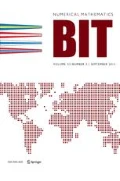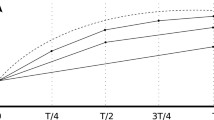Abstract
The direct numerical solution of the chemical master equation (CME) is usually impossible due to the high dimension of the computational domain. The standard method for solution of the equation is to generate realizations of the chemical system by the stochastic simulation algorithm (SSA) by Gillespie and then taking averages over the trajectories. Two alternatives are described here using sparse grids and a hybrid method. Sparse grids, implemented as a combination of aggregated grids are used to address the curse of dimensionality of the CME. The aggregated components are selected using an adaptive procedure. In the hybrid method, some of the chemical species are represented macroscopically while the remaining species are simulated with SSA. The convergence of variants of the method is investigated for a growing number of trajectories. Two signaling cascades in molecular biology are simulated with the methods and compared to SSA results.
Similar content being viewed by others
References
D. Adalsteinsson, D. McMillen, and T. E. Elston, Biochemical Network Stochastic Simulator (BioNetS): software for stochastic modeling of biochemical networks, BMC Bioinform., 5 (2004), 24.
D. F. Anderson, Incorporating postleap checks in tau-leaping, J. Chem. Phys., 128 (2008), 054103.
A. Arkin, J. Ross, and H. H. McAdams, Stochastic kinetic analysis of developmental pathway bifurcation in phage λ-infected Escherichia coli cells, Genetics, 149 (1998), pp. 1633–1648.
N. Barkai and S. Leibler, Circadian clocks limited by noise, Nature, 403 (2000), pp. 267–268.
H.-J. Bungartz and M. Griebel, Sparse grids, Acta Numer., 13 (2004), pp. 147–269.
K. Burrage, M. Hegland, S. MacNamara, and R. B. Sidje, A Krylov-based finite state projection algorithm for solving the chemical master equation arising in the discrete modeling of biological systems, in Proceedings of the 150th Markov Anniversary Meeting, A. N. Langville and W. J. Stewart, eds., Boson Books, Raleigh, NC, 2006, pp. 21–38.
Y. Cao, D. Gillespie, and L. Petzold, Multiscale stochastic simulation algorithm with stochastic partial equilibrium assumption for chemically reacting systems, J. Comput. Phys., 206 (2005), pp. 395–411.
Y. Cao, H. Li, and L. Petzold, Efficient formulation of the stochastic simulation algorithm for chemically reacting systems, J. Chem. Phys., 121 (2004), pp. 4059–4067.
W. E, D. Liu and E. Vanden-Eijnden, Nested stochastic simulation algorithm for chemical kinetic systems with multiple time scales, J. Comput. Phys., 221 (2007), pp. 158–180.
M. B. Elowitz, A. J. Levine, E. D. Siggia, and P. S. Swain, Stochastic gene expression in a single cell, Science, 297 (2002), pp. 1183–1186.
S. Engblom, Computing the moments of high dimensional solutions of the master equation, Appl. Math. Comput., 180 (2006), pp. 498–515.
S. Engblom, A Discrete Spectral Method for the Chemical Master Equation, Technical report 2008-005, Dept. of Information Technology, Uppsala University, Uppsala, Sweden, 2008, available at http://www.it.uu.se/research/publications/reports/2008-005/.
R. Erban, I. G. Kevrekidis, D. Adalsteinsson, and T. C. Elston, Gene regulatory networks: A coarse-grained, equation-free approach to multiscale computation, J. Chem. Phys., 124 (2006), 084106.
L. Ferm and P. Lötstedt, Adaptive solution of the master equation in low dimensions, Appl. Numer. Math., in press, 2008, doi:10.1016/j.apnum.2008.01.004.
C. W. Gardiner, Handbook of Stochastic Methods, 3rd edn., Springer, Berlin, 2004.
M. A. Gibson, J. Bruck, Efficient exact stochastic simulation of chemical systems with many species and many channels, J. Phys. Chem., 104 (2000), pp. 1876–1889.
D. T. Gillespie, A general method for numerically simulating the stochastic time evolution of coupled chemical reactions, J. Comput. Phys., 22 (1976), pp. 403–434.
D. T. Gillespie, Approximate accelerated stochastic simulation of chemically reacting systems, J. Chem. Phys., 115 (2001), pp. 1716–1733.
D. T. Gillespie and L. R. Petzold, Numerical simulation for biochemical kinetics, in System Modeling in Cellular Biology. From Concepts to Nuts and Bolts, Z. Szallasi, J. Stelling, and V. Periwal, eds., MIT Press, Cambridge, MA, 2006, pp. 331–353.
E. Haseltine and J. Rawlings, Approximate simulation of coupled fast and slow reactions for stochastic chemical kinetics, J. Chem. Phys., 117 (2002), pp. 6959–6969.
M. Hegland, C. Burden, L. Santoso, S. MacNamara, and H. Booth, A solver for the stochastic master equation applied to gene regulatory networks, J. Comput. Appl. Math., 205 (2007), pp. 708–724.
A. Hellander and P. Lötstedt, Hybrid method for the chemical master equation, J. Comput. Phys., 227 (2007), pp. 100–122.
C.-Y. F. Huang and J. E. Ferrel Jr., Ultrasensitivity in the mitogen-activated protein kinase cascade, Proc. Natl. Acad. Sci. USA., 93 (1996), pp. 10078–10083.
L. Huber, Mathematical modeling, numerical approximation and computational exploration of gene regulatory processes in the lambda phage, M.Sc. thesis, Centre for Mathematics and its Applications, Australian National University, Canberra, Australia, 2006.
T. Jahnke and W. Huisinga, Solving the chemical master equation for monomolecular reaction systems analytically, J. Math. Biol., 54 (2007), pp. 1–26.
B. N. Kholodenko, Negative feedback and ultrasensitivity can bring about oscillations in the mitogen-activated protein kinase cascades, Eur. J. Biochem., 267 (2000), pp. 1583–1588.
D. Longo and J. Hasty, Dynamics of single-cell gene expression, Mol. Syst. Biol., 2 (2006), 64.
P. Lötstedt and L. Ferm, Dimensional reduction of the Fokker–Planck equation for stochastic chemical reactions, Multiscale Methods Simul., 5 (2006), pp. 593–614.
S. MacNamara, K. Burrage, and R. B. Sidje, Multiscale modeling of chemical kinetics via the master equation, Multiscale Methods Simul., 6 (2008), pp. 1146–1168.
H. H. McAdams and A. Arkin, It’s a noisy business. Genetic regulation at the nanomolar scale, Trends Gen., 15 (1999), pp. 65–69.
J. M. McCollum, G. D. Peterson, C. D. Cox, M. L. Simpson, and N. F. Samtova, The sorting direct method for stochastic simulation of biochemical systems with varying reaction execution behaviour, Comput. Biol. Chem., 30 (2005), pp. 39–49.
J. Paulsson, O. G. Berg, and M. Ehrenberg, Stochastic focusing: Fluctuation-enhanced sensitivity of intracellular regulation, Proc. Natl. Acad. Sci. USA, 97 (2000), pp. 7148–7153.
J. Paulsson and J. Elf, Stochastic modeling of intracellular kinetics, in System Modeling in Cellular Biology. From Concepts to Nuts and Bolts, Z. Szallasi, J. Stelling, and V. Periwal, eds., MIT Press, Cambridge, MA, 2006, pp. 149–175.
M. F. Pettigrew and H. Resat, Multinomial tau-leaping method for stochastic kinetic simulations, J. Chem. Phys., 126 (2007), 084101.
H. Qian, S. Saffarian, and E. L. Elson, Concentration fluctuations in a mesoscopic oscillating chemical reaction system, Proc. Natl. Acad. Sci. USA, 99 (2002), pp. 10376–10381.
C. V. Rao and A. P. Arkin, Stochastic chemical kinetics and the quasi-steady-state assumption: Application to the Gillespie algorithm, J. Chem. Phys., 118 (2003), pp. 4999–5010.
M. Rathinam, L. R. Petzold, Y. Cao, and D. T. Gillespie, Stiffness in stochastic chemically reacting systems: The implicit tau-leaping method, J. Chem. Phys., 119 (2003), pp. 12784–12794.
H. Salis and Y. Kaznessis, Accurate hybrid stochastic simulation of a system of coupled chemical or biochemical reactions, J. Chem. Phys., 122 (2005), 054103.
A. Samant and D. G. Vlachos, Overcoming stiffness in stochastic simulation stemming from partial equilibrium: A multiscale Monte Carlo algorithm, J. Chem. Phys., 123 (2005), 144114.
P. Sjöberg, Numerical Methods for Stochastic Modeling of Genes and Proteins, Ph.D. thesis, Department of Information Technology, Uppsala University, Uppsala, Sweden, 2007.
P. Sjöberg, P. Lötstedt, and J. Elf, Fokker–Planck approximation of the master equation in molecular biology, to appear in Comput. Vis. Sci., 2008, doi 10.1007/s00791-006-0045-6.
N. G. van Kampen, Stochastic Processes in Physics and Chemistry, North-Holland, Amsterdam, 1992.
J. M. G. Vilar, H. Y. Kueh, N. Barkai, and S. Leibler, Mechanisms of noise-resistance in genetic oscillators, Proc. Natl. Acad. Sci., 99 (2002), pp. 5988–5992.
Author information
Authors and Affiliations
Corresponding author
Additional information
AMS subject classification (2000)
65C20, 60J25, 92C45
Rights and permissions
About this article
Cite this article
Hegland, M., Hellander, A. & Lötstedt, P. Sparse grids and hybrid methods for the chemical master equation . Bit Numer Math 48, 265–283 (2008). https://doi.org/10.1007/s10543-008-0174-z
Received:
Accepted:
Published:
Issue Date:
DOI: https://doi.org/10.1007/s10543-008-0174-z




